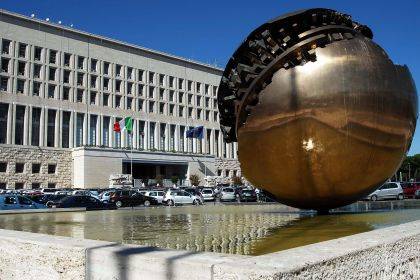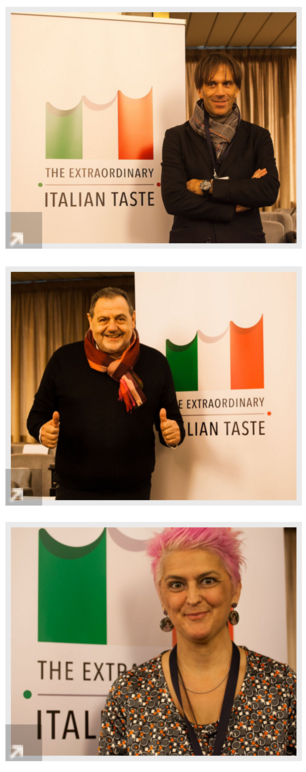Italy's Worldwide Ambassadors: Fine Cuisine and Top Chefs
ROME -- Fundamental within the deep-rooted and multi-faceted Italian culture, its cuisine is also an ambassador whose role is to put Italy's best foot forward. In recognition of this, on March 15 the Foreign Ministry in Rome hosted a meeting at which a worldwide campaign to promote fine Italian cuisine and wines was launched. The meeting brought a hundred or so international diplomats and cultural figures together with, among others, Italian chefs and sports authorities. Presenting the campaign were three cabinet ministers: Agriculture Minister Maurizio Martina, Foreign Minister Paolo Gentiloni, and Education Minister Stefania Giannini.
Launching the “Italian Cuisine Week”
Events within the promotional campaign are to begin with organization of an annual ItalianCuisine Week, to be held every November. "The Foreign Ministry will coordinate promotion of our country's haute cuisine and its quality enogastronomic products worldwide through our network of cultural, consular and diplomatic posts," said Minister Gentiloni. "The top Italian chefs will be on hand to help us. Our goal is to promote the real 'Made in Italy' abroad so as to reinforce in coming years our position among consumers on foreign markets, and to win new ones."
Secondly, selected foreign chefs will be enabled to attend master classes teaching the subtleties of Italian haute cuisine and its finest wines. The aim is also to make better known the benefits of the Mediterranean diet itself. Third, foreign chefs under 30 years of age will be able to apply for scholarships to attend cooking schools in Italy. Not least, Italian Cuisine Days will feature prominently at international sports events, including the Olympic Games to be held this year at Rio De Janeiro. Countries to be featured during the first phase of this ambitious program include the U.S.A., China, Russia, Brazil, and the Emirates. Promotions will then be extended to Australia, Turkey and elsewhere in Europe.
The initiative is partly a continuation of the success at Expo 2015 in Milan enjoyed by quality Italian foods and wines. The government of Premier Matteo Renzi credits Expo for helping to boost Italy's agro-alimentary sector foreign earnings to $41 billion, up 7.5% over the previous year. "This extraordinary result," said Minister Martina, "signifies that our objective of raising foreign earnings from the sector to $55 billion by 2020 is absolutely within our reach." Important for a nation where youth unemployment is an aggravating problem, the number of young people working in the sector has increased during the same period by 16%, he said, representing 20,000 newly employed.
With 280 foods and 523 products officially certified for quality, Italy ranks foremost in Europe. It stands tops in world wine production, with almost 50 million hectoliters (1,320.8 million gallons) annually. While promoting this, at the same time the new campaign goals will include reduction of food waste, fostering school education in healthy eating for young Italians, continuing to guarantee protection of consumers, and development of programs for feeding the indigent.
The rich history of Italian food
Behind the novelties is Italy's culinary sophistication with its deep background. The ancient Roman banquet, which featured such delicacies as flamingo tongues and spit-roasted rare birds, was mythical, but ended with the fall of the Roman Empire in 476 AD. After a lengthy gastronomic hiatus during the barbarian invasions, around the 9th C the Arab colonizers of Sicily introduced new manners of cooking which included dried pasta, in use by nomad peoples because easy to transport. From Genoa and Naples its use spread to France and Spain.
Monasteries kept meat off the menu, but in the l3th century foods improved, with the revival of ancient traditions and with innovations such as spices and cane sugar. Fairly wealthy by the 14th century, Tuscany moved into the gastronomic forefront. A bread enriched with honey, spices, dried figs and raisins was developed in Prato, and is believed to have been a precursor of the Milanese panettone and the panforte of Siena.
Italian Renaissance banquets are thoroughly documented, like that in Castel Sant'Angelo in Rome in 1593. A gastronomic writer named Vincenzo Cervio reported that it was attended by 1,000 people, who dined on pheasants whose feathers were shimmering with gold leaf. Three lions were made of pasta reale, and there were cold dishes in molds of lions, tigers and eagles. At the end of the meal a model of the Castel Sant'Angelo itself appeared, and out of it flew live birds. (Those who read Italian will enjoy reading "Cibo che Passione, La storia della cucina Italiana," from which I am quoting, see >>)
Pasta on the rise worldwide
Today’s hungry world is ever more eager to devour that traditional Italian resource, pasta, as statistics demonstrate. In 2005 Italy produced some 3.2 million tons of pasta, but by 2014 the figure had surged to almost 3.7 million tons, with a further boost in production and in exports last year. Pasta sales figures reflect this renewed popularity worldwide. Dried pasta remains the biggest money earner, but egg-laced pastas, such as fettuccine, and "pasta farcita" (that is, with a filling, as in ravioli stuffed with pumpkin, mushrooms or cheese), are also ever more popular, both in Italy and abroad.
Along with industrial production, today's best-selling pastas abroad reflect an upsurge in the pasta cottage industry, particularly in the Campania and Puglie. What could be called craft pastas have become a favorite of chefs everywhere who cater to gourmet clients. The slow drying process, which requires up to four days, requires time, patience and space, along with equipment that keeps air moving and the heat at the regulation temperature of around 40 to 45 C degrees.
"We have sold our craft pasta even to the Fiji Islands," proud producer Nicola Russo, founder of the Pastificio Artigianale Nicola Russo, who comes from Cicciano near Naples, told a reporter for La Repubblica daily. His family firm dates from the 19th century, but he struck out on his own in 2011. "Our secret: top quality ingredients to begin with, and then slow, slow drying."
Giovanni Assante, head of the Gerardo Di Nola Pastificio, says that his company exports some 60% of its production, primarily to the U.S.A., Europe, Brazil and Peru. His is another cottage industry pasta from near Naples, but even in the north of Italy, craft pasta production is on the rise.
Italy as an “integrated system”
Educating the world to the quality of Italian cuisine and its gastronomic as well as historical and cultural roots has thus become imperative for Italy’s government, food producers and top chefs. This is part of a broader effort to make Italy work “as an integrated system” abroad—the main goal indeed of the Foreign Ministry’s Direzione Generale Sistema Paese, a department specifically dedicated to the promotion of what is called “Sistema Italia,” now headed by Ambassador Vincenzo De Luca. Everyone at the meeting agreed on this admittedly difficult but ambitious and long-needed goal. "Until now too little has been done to let people know what our top cuisine is all about," the noted icon-chef Carlo Cracco commented. "But together we are winners, and that is why we are here today."








































i-Italy
Facebook
Google+
This work may not be reproduced, in whole or in part, without prior written permission.
Questo lavoro non può essere riprodotto, in tutto o in parte, senza permesso scritto.